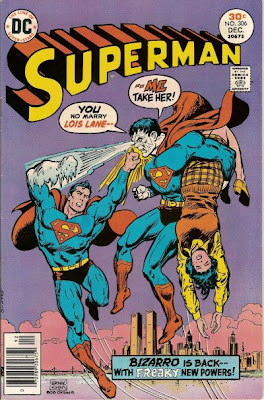But What Kids Don't Know is that that wasn't always the case; and that the change was specific and intentional. For that, we'll have to take a look at Superman #306.
It's easy to see why writers want to use Bizarro as a villain. First and foremost, they can have no qualms about portraying him as Superman's equal, who can fight him to a standstill. Besides, he's a colorful and unpredictable character, engaging for the readers and challenging for Superman (qualities that Superman foes do not always have in abundance).
But before Superman 306, Bizarro was more an annoyance than a villian. He was that Big Dumb Dog who doesn't know his own strength and knocks stuff over (like, say, your guests) at a party. The main threat wasn't that he would fly around killing people; it was that he would expose Clark Kent's secret identity or become, um, too chummy with Lois, let's say.
 Once he had a whole planet of his own (Bizarro World, or "Htrae") to muck about on, Bizarro became mostly comic relief or even (in desperate straights) an ally Superman could call on. Because being the most powerful super- being on Earth and having a bunch of super-powered robot duplicates, a supercousin, an entire city full of microscopic superallies, and a dog that can bite through steel is not always enough, you know.
Once he had a whole planet of his own (Bizarro World, or "Htrae") to muck about on, Bizarro became mostly comic relief or even (in desperate straights) an ally Superman could call on. Because being the most powerful super- being on Earth and having a bunch of super-powered robot duplicates, a supercousin, an entire city full of microscopic superallies, and a dog that can bite through steel is not always enough, you know.Bizarro's original schtick was that he was "imperfect", and "imperfect duplicate" of Superman. He wasn't "the opposite" of Superman, just a badly defective version. His grammar was fractured, his features craggy and white, his intellect impaired. Defective ... not opposite. His powers were the same as Superman's and his costume was the same as Superman's (no, his chest logo was NOT reversed).
Bizarro the Well-Intentioned Buffoon, however, got played out and pretty much disappeared after 1965. But the seeds of what would become of him later were sown in the first line of the 'constitution' of Htrae: the Bizarro Code. "Us do opposite of all earthly things!" This became the basis for Bizarro becoming less an "imperfect Superman" and more an "anti-Superman", who could believably be a part of the comics' Secret Society of Supervillians and television's Legion of Doom (both of which happened in the Bronze Age).
What Kids Today Don't Know is that the move to make the DCU a little less goofier and a little more threatening isn't something that happened suddenly or magically with Crisis on Infinite Earths. Marvel ex-patriate Marv Wolfman did not invent tragedy, folks; the Greeks did.
Darkening the DCU in fact was one of the major thrusts of the Bronze Age. Oh, it may not seem like it to a fan of the Golden Age, where corpses lay at the entrance to every alley. And it may not seem like it to a reader in the modern era, where severed heads fly around like it's the Pantha Family Picnic. But don't be one of those ignorati who lump the Golden, Silver, and Bronze Ages together as one big happy innocent "Pre-Crisis" romp; the shift in tone between the Silver Age and the Bronze Age was HUGE.
In the Bronze Age, goofy sidekick Snapper Carr betrayed the Justice League to the Joker. Robin left Batman. Speedy, one of the original Golden Age sidekicks, got hooked on heroin. Martian Manhunter was deemed so ridiculously and irredeemably Silver Age that he was given a bus ticket off planet and virtually disappeared. An evil (or at least really tacky) conglomerate bought the frickin' Daily Planet, people. A depowered Wonder Woman tortured prisoners and used an uzi. The Flash was tried for murder. I mean, really, folks. What else do ya need to be able to see it? Hal Jordan having a sexual relationship with a 13 year old girl?! Oh, that's right; he DID.
So when Bizarro was reintroduced in the Bronze Age, all was not wacky fun and games. As we shall see in my next post... .


Essentially correct, but don't forget how Arnold Drake and Carmine Infantino broke with the Silver Age sunshine by portraying a squalid carny and a high-wire acrobat whose take on humanity was that everyone in the audience came to watch him die on the flying trapeze.
ReplyDeleteI was introduced to comics in the Bronze age, early 70s. At the same time, DC put out the 100-Page Super-Spectaculars with lots of reprints. And I did always feel like the Silver age stuff was in comparison, although charming, kinda toothless. Well, except for anything written by Arnold Drake, yes. And the Shooter Legion.
ReplyDeleteThe darkest moment of the Bronze Age had to be Arthur Jr's murder by Black Manta. Jesus, the kid was what, four years old, and he suffocated to death on panel.
ReplyDeleteBy the way, if nobody can get Aquaman to work right these days, look back to Arthur Jr's death as the root of it all. That's what screwed up Aquaman's family life, and by extension, his position as an Atlantean monarch.